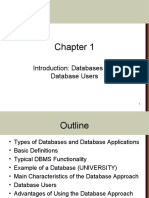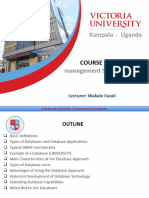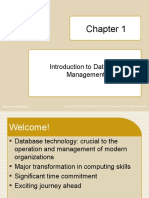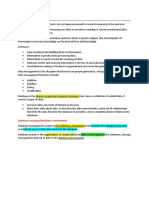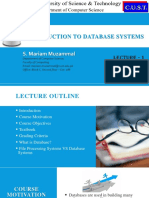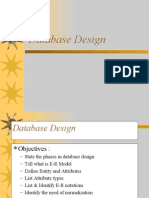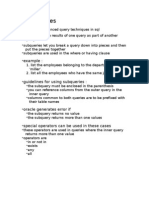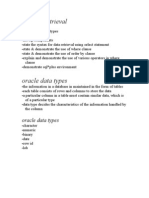Course conduct
• Number of sessions
• Theory / Lab Days, Timings
• How to follow Lab sessions
• Expectations from Students
• About Oracle courseware
1
Oracle course Breakup
• Introduction to DBMS
• SQL
• PL/SQL
• Oracle Architecture
2
List of Books
• Oracle 9i : The complete Reference
(Oracle Press)
• SQL, PL/SQL Programming Language of
Oracle8 By
Ivan Bayross (BPB publication)
• SQL for Professionals
By Kishore, Naik (TMH)
3
INTRODUCTION
TO
DBMS
Introduction to DBMS
• Objectives -
– Identify the need of DBMS
– Distinguish between manual and computerised
database management
– State the evolution of DBMS
– State what is Database
– List the components of a Database
– Describe DBMS characteristics
5
Key to Success
Judgemen
t Informatio
n
Succes
s
Data Knowledg
e
6
Key to Success
Succes
s
Decision
Judgemen
t
Reasonin
Knowledg g
e
Analysis
Informatio
n
Organise
Data
7
Approaches to
Data Management
• Data Management goals
– Convenient and efficient retrieval
– Updating operations
• Types
– Manual Data Management
– DBMS ( Computer based)
8
Manual Data Management
• Problems & limitations in Manual Data
Management
– Physical volume of data
– No sharing
– Data isolation
– Data Redundancy
– Diffused Responsibilities
– Difficult access to the data
– Poor support for concurrent access to the data
– Weak Integrity / unsatisfactory security measures
9
Evolution of DBMS
• The evolution of database management
system was accompanied and promoted by
advancements in computing
– Hardware
– Operating System
– Networking
10
Evolution of DBMS
• Technological Advancement in Data
Management
– Using computers to speedup processing of data
– Advancement of processing power & storage
devices
– Sharing data among multiple user
– Centralized to distributed processing
– Centralized to distributed databases
11
Changes in
Computing Scenario
• Mainframe / Host based Computing
• File Server / LAN based Computing
• Client Server Computing
• Web Based Computing
12
Mainframe / Host based
Computing
The Server / Terminal Model : Dumb Client / Smart Server ( e.g. : Unix Environment )
Minicomputer
or Mainframe
Local
Terminal
Modem
Remote
Modem Terminal
13
File Server / LAN based
Computing
The File Server Model : Smart Client / Dumb Server
PC PC
Network Cable
Changed data file sent to the server
Data file sent to the PC
PC
File Server
14
Client / Server Computing
The Client/ Server Model : Smart Client / Smart Server
Query
PC PC
Query Results
Database
Server
Network Cable
PC
File Server
15
Definition of a Database
• Database is a collection of facts
• Database is a self describing organised
collection of integrated data
16
Components of a Database
• Fundamental components of database are
– User/Application data
• Actual data / facts
– Data Dictionary
• Data about Data
• Data that describes data
– Overhead data
• Indexes, Integrity etc...
17
DBMS Characteristics
• Control of Data Redundancy
• Sharing of Data
• Maintenance of Integrity
• Support for Transaction Control and Recovery
• Data abstraction
• Data Independence
• Availability of Productivity Tools
• Control over Security
18
DBMS Characteristics
• Control of Data Redundancy :
– DBMS does not automatically remove
redundancies but help to control redundancy
• Sharing of Data :
– DBMS allows many applications to share the
data
– Data sharing is in a controlled manner
19
DBMS Characteristics
• Maintenance of Integrity :
– Integrity of data refers to the correctness, consistency
and interrelationship of the data with the application
which uses the data
– Entity Integrity
• Primary key
• Domain of values
– Referential Integrity
• Interrelationship between different data files /
tables
20
DBMS Characteristics
• Support for transaction control and Recovery
:
– Transaction is a series of operations (updates)
treated as single logical transaction (atomic)
– With transactions database is never in a state
where only some updates have taken place
21
DBMS Characteristics
• Data Abstraction :
– Different views from different planes / levels
– External view
• User / application view
– Conceptual view
• Logical view
– Internal View
• Details about the structure of data
• Physical storage of Information
22
DBMS Characteristics
• Data Independence :
– The way information is stored and the way
information is used is independent of each other
– The data and application are independent
• Logical data independence
• Physical data Independence
23
DBMS Characteristics
• Availability of Productivity Tools :
– Provides sophisticated tools for increased
programming productivity and end user
computing tools such as
• Powerful query languages
• Screen and report painters
• Other 4GL tools, etc.
24
DBMS Characteristics
• Control over security :
– DBMSs provide tools by which the DBA can
ensure security of the data
– Use of
• User Code, Password
• Privileges, Roles
25
DBMS Characteristics
• Processing speeds :
– DBMSs provide a lot of facilities over
conventional file systems
– Continuos efforts towards making DBMSs
more efficient
26
DBMS Characteristics
• Hardware Independence :
– Most DBMSs are available across hardware
platforms and operating systems
– Applications can be easily ported
27
















